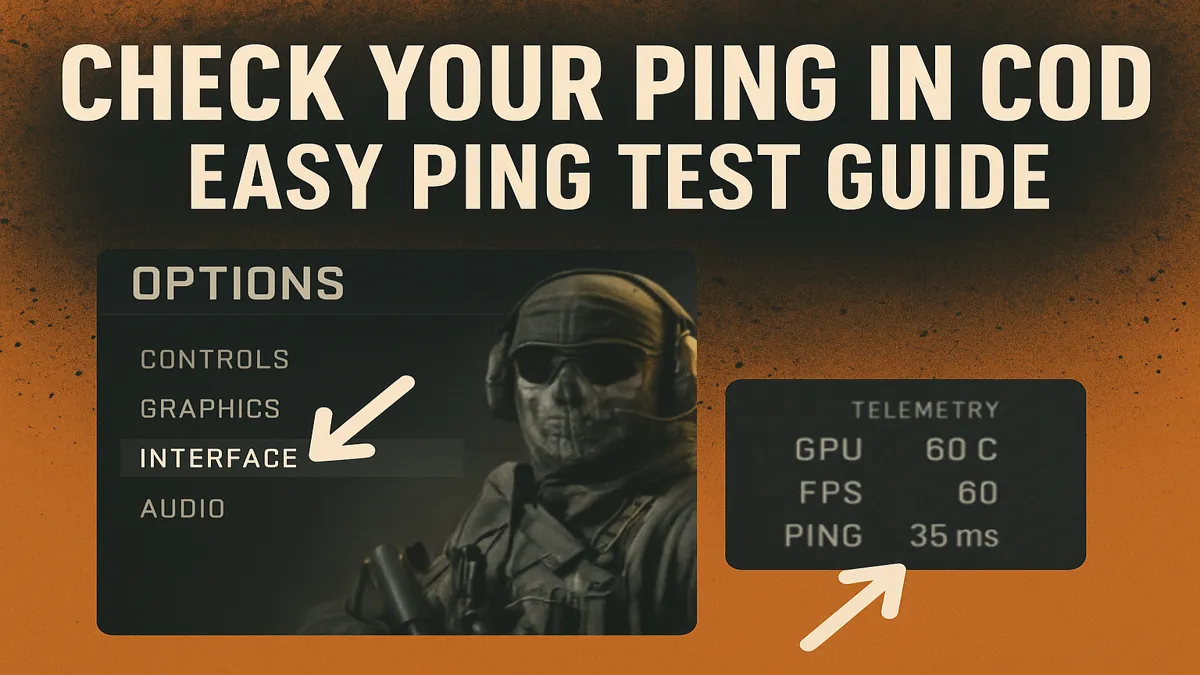Why Ping Matters in Call of Duty
In online multiplayer games like Call of Duty, ping is one of the most important performance metrics. Simply put, ping measures the time it takes for your device to send a signal to the game server and receive a response. In Call of Duty, where battles unfold in split seconds, even a small delay can mean the difference between winning a firefight and watching the killcam. A low ping translates to smoother gameplay, faster response times, and fewer frustrating moments where you feel like you shot first but still lost the duel. For this reason, many players actively look for ways to run a COD ping test before launching into competitive matches. Understanding and managing your ping is the first step toward optimizing your Call of Duty experience.
What a COD Ping Test Actually Measures
A COD ping test doesn’t just spit out a random number—it provides a snapshot of your connection’s responsiveness to Call of Duty servers. When you perform such a test, your device sends small packets of data to a game server and measures how long it takes for the server to respond. The result is shown in milliseconds, usually abbreviated as “ms.” A ping under 30 ms is considered excellent, 30–60 ms is good, 60–100 ms is acceptable, and anything higher than 100 ms may start causing noticeable lag. This measurement can fluctuate depending on your internet connection, your location relative to the server, and the quality of your network equipment. By doing a COD ping test regularly, you can track these numbers and anticipate whether you’ll have smooth gameplay or need to troubleshoot.
The Difference Between Ping, Latency, and Lag
Players often confuse ping, latency, and lag, but they aren’t exactly the same. Ping is the specific measurement of how long data takes to travel back and forth. Latency is a broader term that includes other factors such as processing delays in your router or game client. Lag is the in-game manifestation of high ping or latency—your shots feel delayed, opponents seem to teleport, or your character reacts a second too late. When you conduct a COD ping test, you’re specifically measuring the raw network speed to the server. However, reducing ping alone doesn’t guarantee lag-free gameplay if your network suffers from packet loss, jitter, or bandwidth congestion. That’s why understanding these distinctions is critical for players who want to optimize their Call of Duty sessions.
How to Perform a COD Ping Test Easily
Running a COD ping test is straightforward, and you don’t need advanced technical knowledge. One of the simplest methods is to use in-game tools. Call of Duty titles often allow players to see their ping directly in the game’s settings or during matches. This real-time display shows how well your connection is handling the server traffic. Another option is to use dedicated third-party ping test websites or apps that let you target specific Call of Duty servers. By selecting the closest server, you get a more accurate representation of your expected in-game experience. For players who want more detail, using command prompt tools like “ping” or “tracert” on Windows can help identify where delays occur in the network path. Each of these methods gives valuable insight into your network performance and helps you identify whether it’s time to make adjustments before you queue up for a match.
Ideal Ping Ranges for Competitive Play
Not all ping values are created equal, and competitive Call of Duty players aim for the lowest possible numbers. If you run a COD ping test and see results between 0 and 30 ms, you’re in excellent shape for competitive matches. A range between 30 and 60 ms is still perfectly playable, with only minor delays that most players won’t notice. However, once your ping climbs into the 80–100 ms range, you may start experiencing inconsistencies in hit detection or delayed reactions. Anything higher than 100 ms can become frustrating, especially in modes where reaction speed determines outcomes. Many professional players refuse to compete with ping higher than 50 ms because of the competitive disadvantage it creates. Knowing your ideal ping range helps you evaluate whether your setup is ready for serious matches or better suited for casual play.
Common Causes of High Ping in COD
If your COD ping test shows numbers higher than you’d like, several factors may be responsible. The most common culprit is the distance between you and the game server. The farther you are geographically, the longer data takes to travel. Another frequent issue is network congestion, which occurs when too many devices in your home are using the internet at the same time—streaming videos, downloading files, or running updates in the background. Outdated routers and modems can also introduce delays, as can wireless connections that suffer from interference. Even your Internet Service Provider (ISP) may throttle gaming traffic during peak hours. Identifying which of these factors is causing your high ping is the first step toward solving it, and regular testing can help pinpoint the issue.
How to Lower Ping for a Better COD Experience
Lowering your ping requires a combination of technical adjustments and practical choices. A wired Ethernet connection is almost always faster and more stable than Wi-Fi, so plugging your gaming device directly into the router can drastically improve your results. Closing background applications that consume bandwidth, such as video streaming services, also frees up resources for Call of Duty. Upgrading to a more modern router or switching to a gaming-optimized plan from your ISP can yield further improvements. Running a COD ping test after each adjustment allows you to see the direct impact of these changes. For players who want an extra edge, tools like a Call of Duty game booster can help by prioritizing gaming traffic and reducing unnecessary background processes, ensuring your connection focuses on the game.
The Role of a Call of Duty Game Booster
A Call of Duty game booster is specialized software designed to optimize your PC or console for smoother gameplay. Unlike general system cleaners, a game booster focuses on enhancing your network performance, reducing system resource usage, and ensuring maximum responsiveness. Some boosters automatically close unneeded background processes, free up RAM, and prioritize gaming data packets over other traffic. When combined with a COD ping test, this creates a powerful strategy: you first measure your ping, then apply the booster, and finally test again to see the improvement. Players often find that using a Call of Duty game booster can lower ping, stabilize connections, and even improve frame rates by reducing CPU overhead. While not a magic fix for all network issues, it’s a valuable tool for anyone serious about improving their Call of Duty experience.
Why Server Location Matters
Another critical factor influencing your COD ping test is the location of the game server. Call of Duty uses a network of servers spread across different regions to support its global player base. Ideally, you’ll want to connect to a server geographically close to you. Doing so minimizes the distance your data has to travel, reducing your ping time. Unfortunately, sometimes matchmaking places you on servers farther away due to player availability or party composition. In such cases, your ping may spike unexpectedly. Knowing which servers you usually connect to can help you plan your play sessions. Some players even use VPNs configured to connect them to more favorable server regions, although this comes with mixed results and potential risks. Always run a COD ping test when you notice unusually high latency, as this will confirm whether a distant server is the root cause.
The Impact of Packet Loss and Jitter
While ping is the most commonly measured factor, it’s not the only one affecting your Call of Duty matches. Packet loss occurs when small chunks of data never reach the server, leading to stuttering, rubber-banding, or missing hit registrations. Jitter refers to fluctuations in your ping over time—your connection may average 50 ms but spike up to 150 ms intermittently, making gameplay feel inconsistent. A COD ping test primarily shows average latency, but more advanced tools can reveal packet loss and jitter as well. Addressing these issues often involves improving your network stability rather than raw speed. Upgrading cables, repositioning your router, or switching ISPs can sometimes resolve chronic problems. Players who ignore these secondary factors may still struggle in-game even with seemingly good ping numbers.
Testing Ping Before Every Gaming Session
One of the best habits a competitive Call of Duty player can adopt is running a quick COD ping test before starting a gaming session. This practice helps set expectations and avoid frustration. If you test your ping and notice unusually high numbers, you can troubleshoot before jumping into a match. For example, you might pause downloads, restart your router, or use a Call of Duty game booster to optimize performance. By contrast, if your ping is already excellent, you can enter matches with confidence. Making this test part of your routine ensures consistency and helps identify long-term patterns in your network performance. Over time, you’ll learn what conditions yield your best results and how to replicate them for peak gameplay.
Mobile and Console Considerations
Ping testing isn’t limited to PC players—console and mobile gamers also benefit from checking their network performance. Call of Duty Mobile, for instance, displays ping directly in the corner of the screen, allowing players to see in real time whether their connection is stable. On consoles like PlayStation or Xbox, you can often test network speed and latency directly from the system settings. Performing a COD ping test on these platforms works much the same way as on PC, though with fewer customization options. Console players may also find game boosters useful, especially if they share their home network with multiple users. By reducing background congestion, a booster can help consoles achieve lower latency and more stable connections, leveling the playing field against PC opponents.
The Psychological Advantage of Low Ping
While ping is primarily a technical measurement, it also has psychological effects on players. Gamers who know they have low ping often feel more confident in their abilities, trusting that their inputs will register quickly. This confidence can translate into better performance, faster reactions, and more aggressive playstyles. Conversely, players with high ping may second-guess their actions, hesitate to engage, or blame lag for mistakes. By regularly running a COD ping test and taking steps to improve results, you can eliminate these doubts. Combined with tools like a Call of Duty game booster, you create not just a technical advantage but also a mental edge. In a game as competitive as Call of Duty, where every fraction of a second matters, confidence can be just as important as skill.
Future Improvements in COD Networking
The developers behind Call of Duty continue to refine their networking infrastructure to reduce latency for players worldwide. With advances in server technology and improvements in netcode, future titles may offer even smoother experiences regardless of location. However, individual factors like your home setup, ISP, and network management will always play a role. That’s why understanding the basics of a COD ping test and using tools like a Call of Duty game booster remain essential skills for players. As gaming technology evolves, those who stay proactive about optimizing their connections will always maintain an advantage over less prepared opponents.
Final Thoughts
A COD ping test is more than just a number—it’s a vital diagnostic tool for ensuring the best possible Call of Duty experience. By understanding what ping measures, why it matters, and how to reduce it, players can take control of their online performance. From switching to wired connections and upgrading equipment to using a Call of Duty game booster for extra optimization, every step helps create a smoother and more enjoyable gaming session. Checking your ping before matches, addressing packet loss and jitter, and staying mindful of server locations all add up to better results. In a game where milliseconds determine outcomes, mastering your ping is just as important as perfecting your aim. Whether you’re a casual player or a competitive grinder, making COD ping tests part of your routine will keep you one step ahead of the competition.











